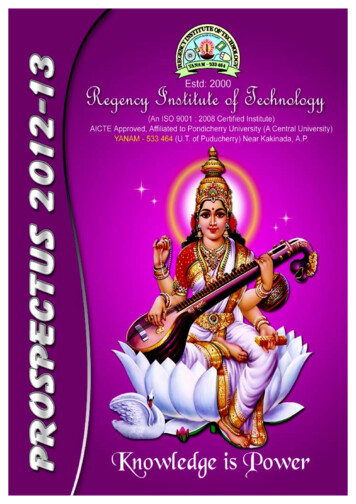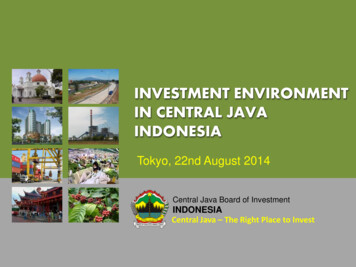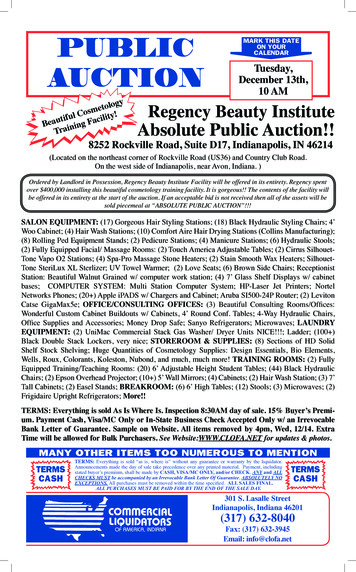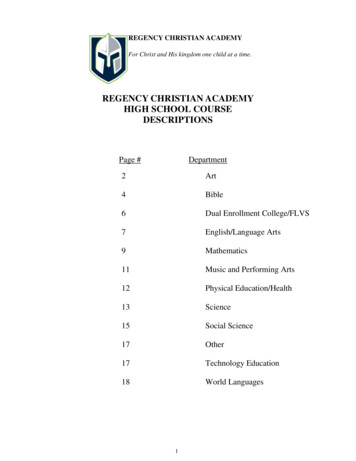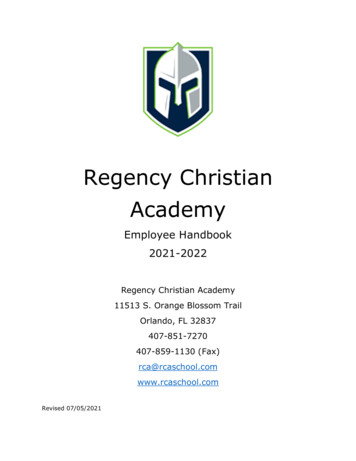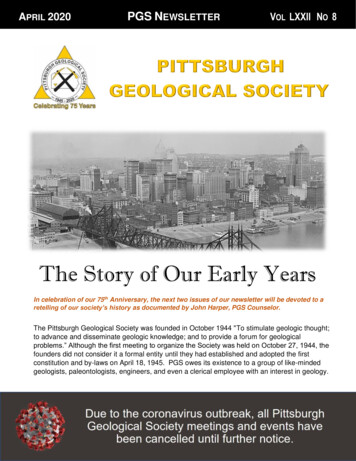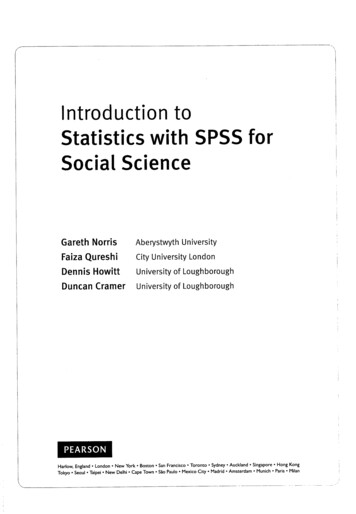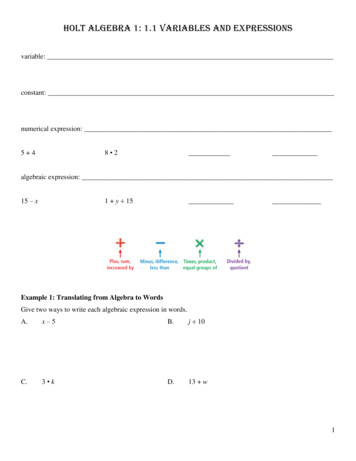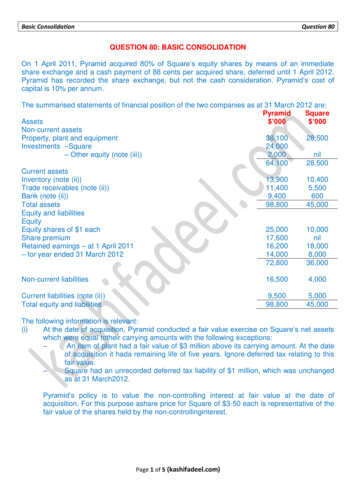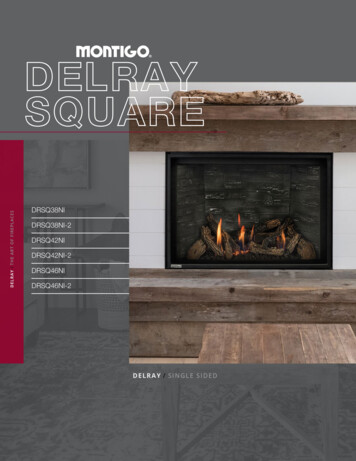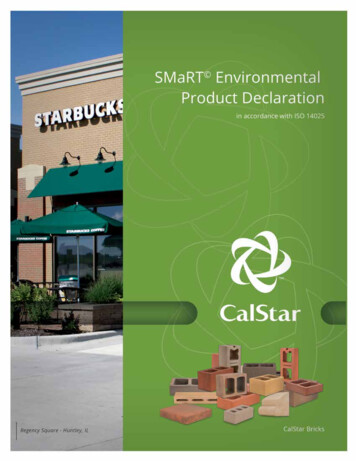
Transcription
Regency Square - Huntley, IL
Product Description:Bricks have long been prized for their classic look, durability, and weather resistance. CalStar Products, Inc. hasdeveloped a proprietary new manufacturing process that reduces manufacturing energy requirements, while producingbricks that meet industry standards, without compromising project aesthetics or budgets. CalStar modular-sizedbrick (3 5/8 x 2 ¼ x 7 5/8 inches) were used for this analysis.CalStar bricks are designed and intended to be used anywhere bricks are used, they are installed using the samematerials (mortar) with the same labor (masons) on the same projects.CalStar bricks contain 37.1% fly ash, which is a post-industrial (pre consumer) recycled material. Fly ash is a wasteproduct of generating electricity from coal, which is generally disposed of in landfills. The CalStar process uses flyash as the binder in bricks, eliminating the need for clay, kiln firing or Portland cement. The entire manufacturing timefor a CalStar brick from raw material delivery to packaging is approximately 24 hours. The CalStar process requiresvery little energy during the life cycle—especially the manufacturing stage—and, as a result, has a small carbon footprint.CalStar’s commitment to environmental performance includes carbon reduction, embodied energy reduction, recyclingindustrial waste, and waste diversion from landfills. CalStar purchases Renewable Energy Credits (RECs) from windenergy to offset half of the manufacturing energy usage. This renewable energy was deliberately not taken into accountduring the life cycle assessment (LCA). The LCA values shown in this document represent the complete life cycle ofCalStar bricks, without accounting for the RECs purchased by CalStar.Manufacturer:CalStar Products, Inc. develops and manufactures sustainable building products that allow customers to dramaticallyreduce the embodied energy and carbon footprint of their projects and incorporate significant recycled materials,without compromising building performance or budgets. Founded in Silicon Valley and headquartered in Wisconsin,CalStar’s mission encompasses the national priorities of supporting energy independence, mitigating climate change,preserving natural resources, recycling industrial waste, and creating green jobs.For more information, visit calstarproducts.comMaterial Declaration:CalStar modular bricks are composed of the materials listed inthis table. (The table shows materials comprising 1% or more byweight.) A single modular brick weighs 3.8 lbs and contains 37.1%post-industrial recycled content (fly ash). Bricks are packaged in cubes,with 530 modular bricks in a cube. Cubes are strapped together usingrecyclable polyester plastic straps. Cubes are then stretch-wrapped,using recyclable low-density polyethylene.materialweight/brick (lb)amount ofmixturesand2.3455.8%fly ash1.5637.1%water0.255.9%Environmental Product Declaration:CalStar and its users, owners, employees, and stakeholders possess a shared interest in the environment withparticular focus on mitigating climate change through the reduction of product-related embodied energy andassociated greenhouse gas emissions. As such, CalStar commissioned an ISO-compliant life cycle assessment fromleading architectural firm, Perkins Will, to assess the environmental impacts of a CalStar brick throughout its entirelife cycle—including raw materials extraction and transportation, brick production, transportation to job site, use, andend-of-life. The functional unit used in the LCA is one modular brick (3 5/8 x 2 ¼ x 7 5/8 inches) plus associated mortar(mortar joints assumed to be 3/8 inches wide, and run the full depth of the brick). The brick has an 80-year lifeexpectancy, and the LCA accounts for tuckpointing the mortar once (at the 40-year mark) during the life cycle.2 CalStar Products SMaRT Environmental Product Declaration
The LCA was performed by Perkins Will, using Gabi 5.0 software, following the SMaRT Product Criteria Rule (PCR).The SMaRT EPD Policy and PCR documents meet the requirements of the ISO Standards for LCAs and EPDs. It shouldbe noted that the SMaRT PCR is more comprehensive than the standard ISO requirements for reporting ofenvironmental impacts—SMaRT requires eight Life Cycle Impact categories, three more than ISO 21930, includingHuman Health, Criteria Air Pollutants and Ecological Toxicity.Life Cycle Inventory Analysis:The life cycle inventory analysis covers all the life cycle phases, as shown ction useend-of-life-to-Job-to-gravePhase Descriptions:Extraction Phase:This phase includes raw material extraction and transportation to the CalStar manufacturing facility. The sandused is obtained from a local quarry. Fly ash is a waste product from coal combustion for electricity generation.Fly ash is typically disposed of in landfills. By recycling fly ash into bricks, CalStar diverts material from landfills.CalStar uses fly ash from a power plant located 6 miles from the CalStar plant. A CalStar brick contains 37.1%recycled post-industrial material (fly ash).Over 98% of CalStar’s raw materials are sourced within 60 miles of the CalStar plant. As consistent with the SMaRT PCR,CalStar considers two-way transportation for this phase: trucks transport raw materials from their sources to the plant,and then return back to the raw material sources—no backhaul is considered.Manufacture Phase:This phase includes the manufacturing process for CalStar brick. Raw materials are measured into a mixer; mixed fora fixed time; conveyed into a vibrocompaction press hopper; discharged into brick molds; vibrocompacted; ejectedfrom the brick molds; conveyed into curing chambers; cured; conveyed to packaging stations; inspected to ensureconformance with CalStar’s strict quality requirements; and then packaged. Packaging uses recyclable plastic strapsand recyclable LDPE stretch-wrap.As specified by the SMaRT PCR and required by ISO, CalStar includes upstream (also called “primary” or “source”) energyrequired to produce the energy used in the manufacturing process (also called “delivered” or “site” energy).This phase captures the bulk of CalStar’s innovation in reducing environmental impact, which is the result of two primaryinnovations: using an abundant waste material as a critical manufacturing resource, and reducing manufacturing energyneeds. CalStar bricks perform and are used in virtually the same way as conventional brick, but do not require firing athigh temperatures for long periods of time.CalStar Products SMaRT Environmental Product Declaration 3
Construction and Use Phase:This phase includes transportation of bricks and mortar to the jobsite; the mortar used to construct the wall; andthe water required for the mortar. Though the CalStar brick itself is not comprised of mortar, mortar is required to buildthe brick into a functional element, such as a wall or building. As such, the mortar is considered part of the life cycle.CalStar brick uses the same types and amounts of mortar as conventional fired brick.Brick and ingredients for mortar are generally transported on flat-bed trucks on as-needed basis by contract haulers.As such, one-way transportation is considered for this phase, as back-hauls on flat-bed trucks are common andexpected.The construction process itself is fairly low waste, as bricks are modular in nature, requiring that only the number ofbricks needed on a job are actually used. Remaining bricks can be used on other jobs. Likewise, mortar is mixed inbatches, allowing masons to mix only the amount of mortar that is needed for a specific job.The life cycle of a CalStar brick wall or building is defined to be 80 years. Bricks generally need very little maintenance,as they are pest- and weather-resistant, and do not require painting or sealing. However, the front edge of mortar candeteriorate over time. Thus, the life cycle assessment includes tuckpointing the mortar once (removing and replacingthe front edge of mortar in the joints), at about 40 years. Tuckpointing is included in the Construction and Use phase.End-of-Life Phase:This phase includes demolition of the brick and mortar, as well as transportation to a recycling yard or landfill. UsedCalStar brick and mortar can be readily recycled by crushing into an aggregate for road sub-base; the facilities fordoing so are abundant. Therefore, the LCA anticipates that 80% of the material will be recycled and a portion of theenvironmental impacts for mining virgin aggregate, such as CO2 emissions from diesel fuel use, are credited back to theCalStar brick during the end-of-life phase. The LCA anticipates the remaining 20% of the material is landfilled.Environmental Impact ction useend-of-lifetotalGlobal Warming Air(carbon footprint)kg CO20.0050.0530.070-0.0010.127Fossil Fuel Depletion(embodied energy)kg Oil0.0050.0260.0300.0030.063Human HealthCriteria Airkg PM 102.0324.4215.042-1.16110.334Human Toxicitykg 1,4-DB0.1850.2881.763-0.1052.131EcoToxicity - WaterPAF m30.4242.0082.3940.2565.082EcoToxicity - SoilPAF m31.2031.0551.794-2.7131.340EcoToxicity - AirPAF m30.0661.2020.8020.0142.084Water Depletionm30.0040.0210.024-0.0020.046Metal Depletionkg Fe0.0510.2048.1870.0038.445Smog Airkg O30.5732.1613.184-0.2225.697kg CFC 110.8313.0754.805-0.6188.093kg N0.2070.5492.4290.0103.195kg H moles0.0010.0120.0100.0000.023Ozone Depletion AirEutrophication AirAcidification AirExtraction phase includes transportation of raw materials to manufacturing site.Construction phase includes transportation of finished goods and mortar to job site, as well as use of mortar.Use phase includes tuckpointing.End-of-life phase includes recycling and energy required to crush brick for recycled use.4 CalStar Products SMaRT Environmental Product Declaration
Life Cycle Carbon Footprint of CalStar BrickLife Cycle Embodied Energy of CalStar BrickNote: CalStar’s revolutionary manufacturing process dramatically reduces the embodied energy and associatedgreenhouse gas emissions of brick. Nonetheless, the LCA shows that the manufacturing process is responsible forthe largest portion of embodied energy within the life cycle. In keeping with CalStar’s continued commitment to theenvironment, CalStar purchases Renewable Energy Credits (RECs) from wind energy to offset half of the manufacturingenergy usage. This renewable energy is deliberately not taken into account during the life cycle assessment. The LCAvalues shown in this document represent the complete life cycle of CalStar bricks, without accounting for the RECspurchased by CalStar.Maintenance, Quality, DurabilityBrick masonry is known for its durability and longevity. It is a low-maintenance cladding option that requires no paintingand little maintenance. It is generally resistant to weather and pests. It is often considered a premium cladding option.CalStar Products SMaRT Environmental Product Declaration 5
CalStar Brick and SMaRT :CalStar brick is rated Sustainable Platinum by the SMaRT Sustainable Product Standard.SMaRT is a comprehensive, transparent, consensus-based sustainable product standardthat measures a product’s environmental, economic and social benefits over its life cycleand throughout its global supply chain, from raw materials extraction through reclamationor re-use. The SMaRT Scorecard results of different products can be accurately comparedand include LCA results. The CalStar SMaRT Scorecard and SMaRT Certification Summary areavailable at this link:http://mts.sustainableproducts.com/SMaRT Certified.htmlSMaRT & SMaRT EPD SignificanceAll SMaRT Product EPDs are Certified as Sustainable Products, Stockholm TreatyToxic Chemicals/PVC and SF6 free, meet SMaRT’s Carcinogen and Legal OperationsPolicies, use FSC Certified Wood for wood products, and are uniquely comparableand accurately based on life cycle assessment (LCA).CalStar brick is a SMaRT Sustainable Platinum certified product achieving a total of 90 points: 23 points for Safe for Public Health & Environment 31 points for Renewable Energy & Energy Reduction 5 points for Biobased or Recycled Materials 12 points for Facility or Company Based Requirements 4 points for Reclamation, Sustainable Reuse & End of Life Management 15 points for Innovation in ManufacturingBackground on SMaRT & ISO Environmental LabelsSMaRT is a type 1 consensus, performance-based and quantified Ecolabel, an independently third-party verified, multicriteria license to use the SMaRT Label indicating the overall environmental and sustainable preferability of a product ona life cycle basis. Type 2 labels are manufacturer self-claims on the environment without third-party verification. A type 3label is an independent, qualified third-party verified environmental product declaration based on a quantified LCA withset parameters. To increase accuracy, SMaRT EPDs combine the requirements of a type 1 Ecolabel with a transparenttype 3 label. LCAs are best used to obtain supplier environmental impact data and improve product design.CalStar Brick and LEED :CalStar Brick contributes to a number of LEED credits: Materials and Resources Credit 4: Recycled Content, 2 points possible Materials and Resources Credit 5: Regional Materials within 500 miles of our manufacturing facilityin Racine, WI, 2 points possible I nnovation in Design Credits: Exemplary Performance in both Regional Materials and Recycled Content,2 points possible Innovation in Design Credit: SmaRT Certified Materials, 1 points possibleInterpretation:CalStar’s innovative process produces bricks with an extremely small global warming potential (carbon footprint) andvery little fossil fuel depletion (embodied energy). In addition, CalStar bricks contain 37.1% post-industrial recycledcontent that has been diverted from a landfill.6 CalStar Products SMaRT Environmental Product Declaration
Methodology and Certification:The LCA was performed by Perkins Will, using Gabi 5.0 software, following theSMaRT Product Criteria Rule (PCR).This SMaRT Environmental Product Declaration (EPD) was certified by Market Transformation to Sustainability (MTS)November 2012, and expires November 2015.CalStar asserts that the SMaRT EPD Policy and PCR were adhered to in preparation of this Declaration with accurateinformation that is not misleading, and qualified professionals were used, consistent with the FTC EnvironmentalMarketing Guides.SMaRT PCR review consistent with ISO 21930 §§6.2 & 9.1 & ISO 14025 §8.1.2 was conducted by MTS. The SMaRT Committee overseeing this EPD Policy and requirements can be contacted through MTS@sustainableproducts.com.Independent verification of the declaration and data, according to ISO 14025:2006 was performed by an external expertreviewer, Michael Italiano, Founder USGBC. (ISO 14025 §8.1.1)SMaRT EPD third-party verification was conducted by MTS, independent of first parties (suppliers/manufacturers)and second parties (purchasers). The verification is appropriate for business-to-business and business-to-consumercommunications, and consumer and environmental representatives, per the SMaRT EPD Policy, which is consistent withISO 14025 §9.3.MTS was not involved in the development of the ISO-compliant LCA or the EPD, has no conflicts of interests, and is anonprofit IRC §501(c)(3) (ISO 14025 §§8.1.1 & 9.4).MTS is competent to conduct the third-party SMaRT EPD verification pursuant to ISO 14025 §8.2 as documented insection 12 of the SMaRT EPD Policy.References:SMaRT Environmental Product Declaration (EPD) Policy & PCR: http:// mts.sustainableproducts.com/SMaRT/CalStarISO 14025 Environmental labels and declarations—Type III Environmental Declarations—Principal and ProceduresISO 14040 Life Cycle Assessment—Principles and FrameworkISO 14044 Life Cycle Assessment— Requirements and GuidelinesISO 21930 Sustainability in Building Construction—Environmental Declaration of Building ProductsFederal Trade Commission (FTC) Environmental GuidelinesLCA Method and Characterization FactorCalStar Products SMaRT Environmental Product Declaration 7
Contact:For further information, please contact CalStar Products, Inc. at:2825 4 Mile Road Racine, WI 53404Toll Free 877.700.9501 info@calstarproducts.comAlso, find detailed product info and installation advice at calstarproducts.comCalStar Products SMaRT Environmental Product Declaration
materials (mortar) with the same labor (masons) on the same projects. CalStar bricks contain 37.1% fly ash, which is a post-industrial (pre consumer) recycled material. Fly ash is a waste product of generating electricity from coal, which is generally disposed of in landfills. The CalStar process uses fly
